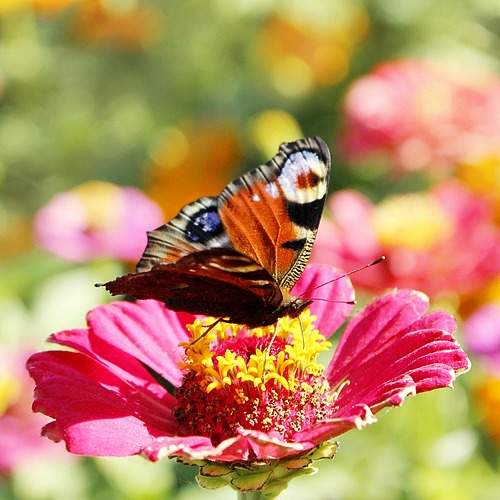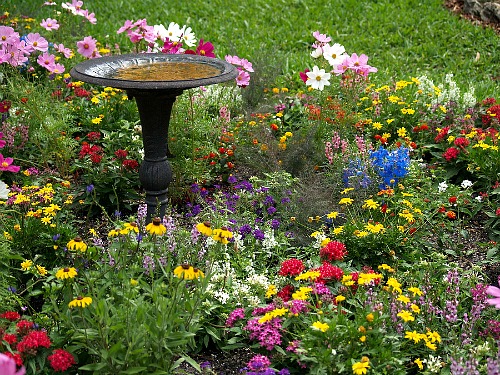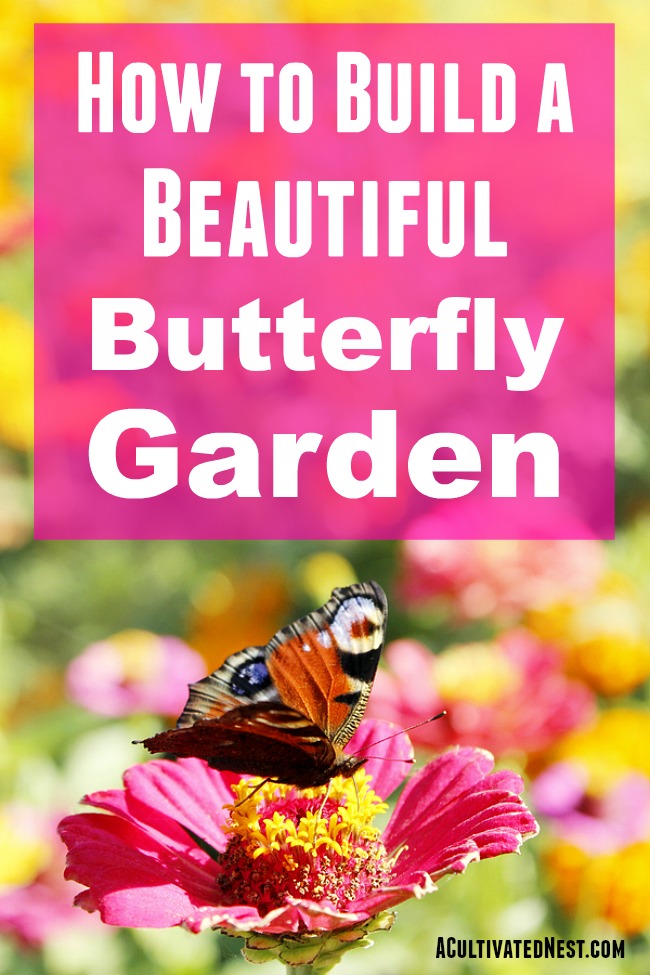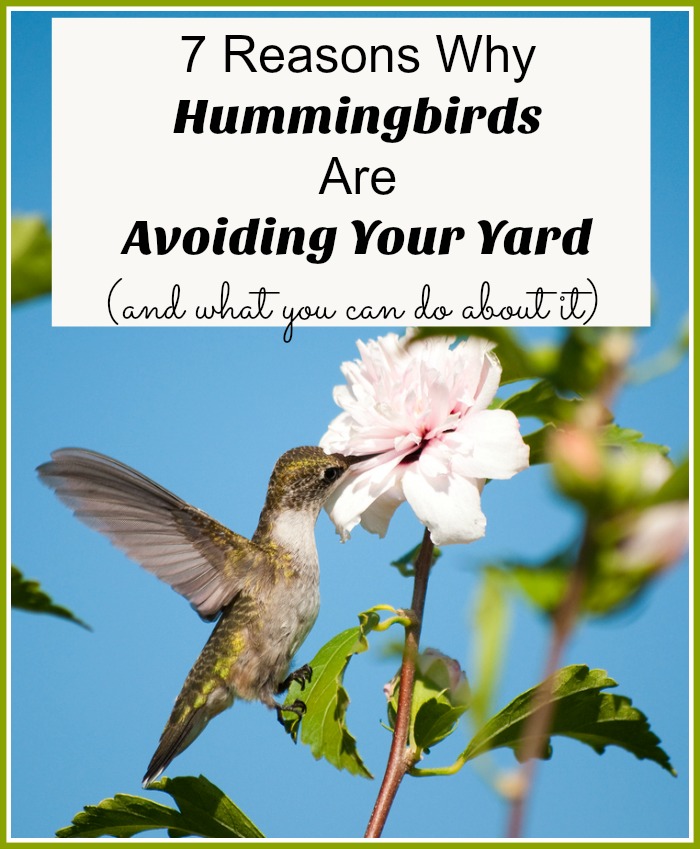Besides begin trendy butterfly gardens are fun, exciting, and can bring your yard one step closer to the magical fairy kingdom! Butterflies are amazing and delightful creatures and besides being almost magical to watch, they also happen to be some serious pollinators. Having an active and healthy butterfly population can make the difference between a successful garden and a not so successful garden. So read my tips on How to Build a Butterfly Garden!

Disclosure: This post may contain affiliate links to Amazon and/or Etsy, which means that I may earn a small commission from some of the links in this post. Please see our Disclosure Page for more information.
This guide isn’t about how to get more butterflies for a month. You want to attract butterflies to your garden and convince them to stay long-term! Like any home, when building your butterfly garden you need to consider food, water, and shelter. Luckily, this is very easy to do when creating your own buttefly garden!
How to Build a Butterfly Garden
Location Location Location
Before we delve into the specific attributes of a butterfly paradise, you need to first consider the best spot in which to put your butterfly garden. Consider a bright sunny spot, with the opportunity for shade. You want the butterflies to have relatively easy access to your other gardens, where they are going to work their pollinating magic skills for your benefit. Also, you want to be able to see and enjoy the butterflies as they enjoy their space – however – you want to make sure they can go about their lives relatively undisturbed. For example, keep the butterfly garden a safe space away from highly traveled walkways, doorways and so on.
Flowers for Butterfly Gardens
It’s important the plant the right flowers if you’re trying to build a butterfly garden. Butterflies seem to really enjoy flowers that are shades of pink and purple. But to be on the safe side – I would search out flowers that span the rainbow.
Blooming time is going to be crucial as well. You want butterflies to have access to their favorite foods throughout their entire life cycle. Plan to have early spring blooms, mid-spring blooms, late spring blooms, early, mid and late summer blooms, as well as early, mid, and late fall blooms as well. The idea is to always have something blooming and available to the butterflies. Consult with your local horticultural society to see what plants your local experienced gardeners recommend.

Some great flower choices for pollinators are Columbine – a hardy perennial that blooms in spring and summer, Delphinium – a hardy and tall perennial that also blooms in spring and summer, and Echinacea (AKA Coneflower), which you could even use to make Echinacea tea! But be careful with Echinacea plants, as they can take over, like dandelions, and aren’t much to look at before they bloom. Hollyhocks are very tall also (they can grow up to nine feet) and are hardy perennials and quite elegant, and Lupins are very hardy, quite unique, and have lovely foliage.
You may also want to choose the flowers for your butterfly garden based on the type of butterflies you want to attract. Some people want to help threatened butterflies (those whose populations are dwindling) by planting those butterflies’ favorite plants (which tend to be plants that are native to their area).
There are lots of butterfly-friendly flowers out there, so do a little research and pick the ones that appeal most to you! The National Wildlife Federation has a handy list of what plants different types of butterfly caterpillars prefer.
Butterfly Garden Furniture
Besides those great big juicy flowers, butterflies love to sun themselves, and they also need water. So before you build a butterfly garden in your yard, take some time to plan out where you could put some little amenities for the butterflies. This way, not only will the butterflies come to eat, they will stay to play.
Give the butterflies the chance to lounge in the sun by placing large flat rocks and overturned ceramic pots strategically and decoratively around the butterfly garden. Make sure they are in the sun to give your residents the chance to stretch their wings and bask in the sunlight.
Water of course is also important – so make sure you have a water source available to the butterflies. An aerated bird bath, bubbling fountain or something similar so that the butterflies can get the water they need. Be sure that you are not leaving puddles of stagnant water however, or you will end up with a mosquito breeding ground. The water needs to be moving and fresh.
Butterfly Garden Protection
Neighborhood cats aren’t butterflies only predators! Butterflies also have to worry about spiders, birds, ants, wasps, and more. You can help keep your backyard butterflies safe by using pesticides (natural ones are safest for you, your pets, and the butterflies) or by using bug traps. The goal is to limit the predator bugs without accidentally harming the butterflies, or their vulnerable larvae! For birds, you can just get reflective bird deterrents to keep the birds away from the butterfly garden portion of your yard.
Winterizing the Butterfly Garden
Cutting back your butterfly garden plants may destroy some butterfly pupae and even some eggs. However, standing dead plant material also harbors pests. Cleaning up the garden in winter will help reduce the incidence of both pests and diseases in the new growing season. In fact, cleaning up debris and leaf litter before the growing season is one of the simplest and most effective pest and disease management strategies that exist.
You may want to leave whatever dead plant material you wish until late winter. Then cut your plants back and clean it up. Plants that you think may have butterfly pupae or chrysalides could be carefully set aside near the garden until any insects have had a chance to emerge come spring. It’s up to you really – you have to go with your gut and your gardening style as you work to build a butterfly garden.
So as you can see, creating a butterfly garden can be very simple, or you can make it more complex. If you’re interested in learning more in-depth about how to make a beautiful and beneficial butterfly garden, check out Gardening for Butterflies: How You Can Attract and Protect Beautiful, Beneficial Insects. It’s written by the Xerces Society, who are kind of like the most knowledgeable beneficial bug people.
What’s your favorite kind of butterfly?
You might also be interested in: 7 Reasons Why Hummingbirds Are Avoiding Your Yard


